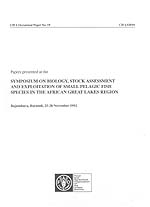
SYMPOSIUM ON BIOLOGY, STOCK ASSESSMENT AND EXPLOITATION OF SMALL PELAGIC FISH SPECIES IN THE AFRICAN GREAT LAKES REGION
| CIFA Occasional Paper No. 19 | CIFA/OP19 |
 | PAPERS PRESENTED AT THE SYMPOSIUM ON BIOLOGY, STOCK ASSESSMENT AND EXPLOITATION OF SMALL PELAGIC FISH SPECIES IN THE AFRICAN GREAT LAKES REGION |
Bujumbura, Burundi, 25 – 28 November 1992.
edited by
Marshall B.E.
Department of Biological Sciences
University of Zimbabwe
P.O. Box MP167, Mount Pleasant
Harare, Zimbabwe
and
R. Mubamba
Department of Fisheries
P.O. Box 350100
Chilanga, Zambia
Preparation of this document
This is the collection of the papers presented at the Symposium on Biology, Stock Assessment and Exploitation of Small Pelagic Fish Species in the African Great Lakes Region. The symposium, jointly organized by the FINNIDA/FAO/AGFUND project “Research for the Management of Fisheries on Lake Tanganyika” (LTR) and the FAO/UNDP project “Inland Fisheries Planning, Development and Management in Eastern/Central/Southern Africa” (IFIP), was held in Bujumbura, Burundi from 25 to 28 November 1992.
The FAO Inland Water Resources and Aquaculture Service contribution to the symposium was to have the papers edited and published.
In brief account of the symposium including conclusions and follow up is contained in technical document number 6 of the LTR project.
Distribution:
CIFA Mailing List
FAO Fisheries Department
FAO Regional Fishery Officers
Authors
Marshall, B.E.; Mubamba, R. (eds.) Papers presented at the Symposium on Biology, Stock Assessment and Exploitation of Small Pelagic Fish Species in the African Great Lakes Region. Bujumbura, Burundi, from 25 to 28 November 1992. CIFA Occasional Paper. No. 19. Rome, FAO. 1993. 270p. ABSTRACT This document contains the papers presented at the Symposium on Biology, Stock Assessment and Exploitation of Small Pelagic Fish Species in the African Great Lakes Region. The symposium, jointly organized by the FINNIDA/FAO/AGFUND project “Research for the management of fisheries on Lake Tanganyika” (LTR) and the FAO/UNDP project “Inland Fisheries Planning, Development and Management in Eastern/Central/Southern Africa” (IFIP), was held in Bujumbura, Burundi from 25 to 28 November 1992. The Lakes and Reservoirs included in the 20 Symposium papers are Itezhi-Tezhi, Mweru-Luapula, Malawi, Kariba, Kibu, Tanganyika and Victoria. The small pelagic species treated are Limnothrissa miodon, Stolothrissa tanganicae, Rastrineobola argentea, Poecilothrissa moeruensis and Engraulicypris sardella. The topics covered include biology, life history, growth and mortality and various aspects of the fisheries. |

FOOD AND AGRICULTURE ORGANIZATION OF THE UNITED NATIONS
ROME, 1993
Hyperlinks to non-FAO Internet sites do not imply any official endorsement of or responsibility for the opinions, ideas, data or products presented at these locations, or guarantee the validity of the information provided. The sole purpose of links to non-FAO sites is to indicate further information available on related topics.
This electronic document has been scanned using optical character recognition (OCR) software. FAO declines all responsibility for any discrepancies that may exist between the present document and its original printed version.
2. STRUCTURE OF THE POPULATION
5. THE PRODUCTION/BIOMASS RATIO
6. THE IMPLICATIONS FOR MANAGEMENT AND RESEARCH
The biology and exploitation of small pelagic fishes in Zambia (by R. Mubamba)
1.1. Emergence of commercial fishing
1.2 Characteristics of the lakes
1.3 Composition, distribution and abundance
1.3.1 Composition
1.3.2 Distribution and abundance
2.1 Stolothrissa tanganicae
2.2 Limnothrissa miodon
2.3 Poecilothrissa moeruensis
2.4 Microthrissa acutirostris
2.5 Microthrissa stappersi
3.1 Engraulicypris moeruensis
3.2 Barbus trimaculatus
6.1 Annual catches
6.2 Composition of catch
6.3 The by-catch issue
Introduction of Lake Tanganyika sardines into Itezhi-Tezhi Reservoir, Zambia (by R. Mubamba)
2.1 Lake Itezhi-tezhi
2.1.1 The first release
2.1.2 The second release
Catch trends of Limnothrissa miodon in Lake Kariba (by J.M.C. Lupikisha)
3.1. Catch and effort trends
3.2. Seasonality
3.3. Number of rigs
3.4. Changes in CPUE
3.5. Total surplus production models
The life history style of Limnothrissa miodon in Lake Kariba (by P.C. Chifamba)
Growth of Usipa (Engraulicypris sardella) in Lake Malawi/Niassa (by A.B. Thompson and A. Bulirani)
2.1. Otoliths
2.2. Length-frequency series
3.1. Otoliths
3.2. Length-frequency series
1.1 General
1.2 A note on the taxonomy of the Chisense complex
1.3 The lake and river system
2.1 Sampling sites and collection of biological data
2.2 Frame survey
3.1 Biological studies
3.1.1 Species composition of the catch
3.1.2 The size of P. moeruensis
3.1.3 Feeding biology
3.1.3.1 Poecilothrissa moeruensis
3.1.3.2 By-catch
3.1.4 Fecundity of P. moeruensis
3.2 Frame survey
3.1 Exploitation
3.2 Predator - Prey Interactions
3.3 A Concluding note on stock assessment.
2. THE BIOLOGY OF THE CLUPEIDS
2.1 Reproductive biology
2.2 Schooling and vertical migration
3.1 Catch
3.2 Marketing
3.3 Collection of Fishery Statistics
2. SAMPLING METHODS AND DATA PROCESSING
3.1. Industrial catches: fluctuations in CPUE and species composition
3.2. Growth
3.3. Inshore life of pelagic species
3.1. Stolothrissa tanganicae
3.2. Limnothrissa miodon
3.3. Lates stappersii
2. HISTORIQUE DU DEVELOPPEMENT
4. DE LA RENTABILITE ECONOMIQUE DES ACTIONS DE PECHE
7. ANALYSE COMPARATIVE DU CAPITAL INVESTI ET REMUNERATION DU
8. RESUME DES CONCLUSIONS ET RECOMMANDATIONS.
3.1 Fishing units and effort
3.2 Catch statistics
3.3 Catch per unit of effort
3.4 Resource evaluation
3.5 The main fishery constraints
4.1 Major problems with catch and effort data recording system
4.2 Cooperation and fishery policy
4.3 Main research topics
3.1 Examen des gonades
3.2 Echantillonnage de larves
3.3 Traitement des données
4.1 Evolution des gonades
4.2 Densité et distribution des larves
4.3 Périodes de reproduction
4.4 Sites de fraie
2.1 The Beach seine
2.2 The lampara or “boat seine”
2.3 Other fishing methods.
3.1 Fishing grounds and sampling sites